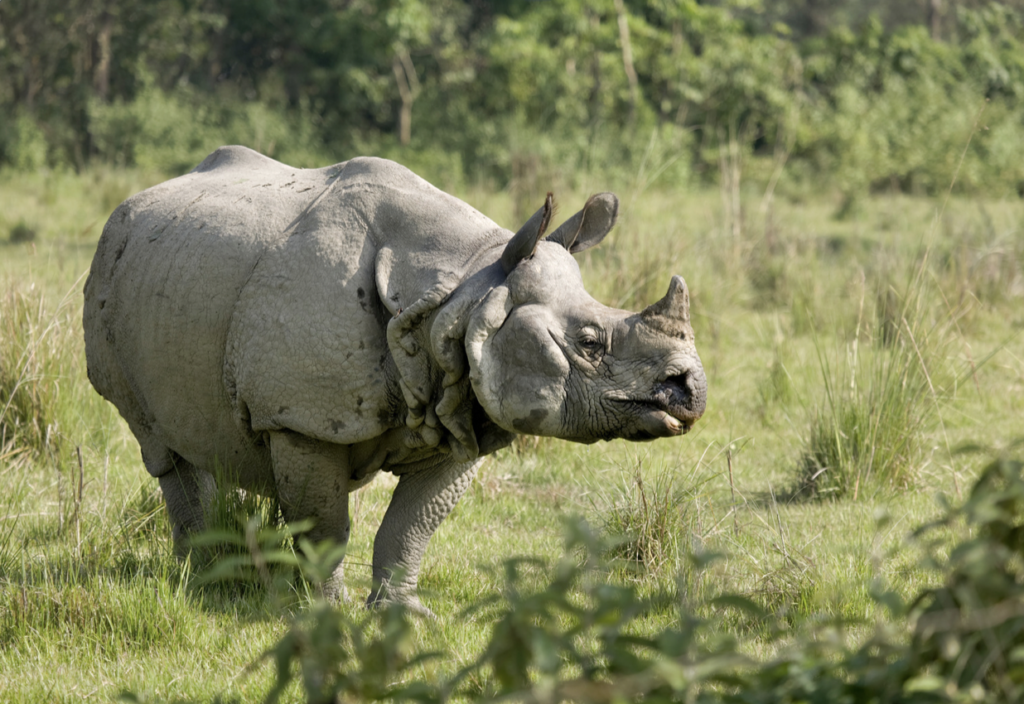Indian Rhino
Species in Peril:
Indian Rhino
A prehistoric armored beauty
Shrinking range
Indian rhinos previously roamed the whole northern Indian Subcontinent, including Bangladesh, the southern regions of Nepal and Bhutan, and the basins of the Indus, Ganges, and Brahmaputra rivers, from Pakistan to the boundary between India and Myanmar. They might have also happened in Indochina, southern China, and Myanmar. They live in the Terai and Brahmaputra basin alluvial grasslands.
Its range rapidly shrunk as a result of habitat loss and climatic changes, and by the 19th century, it was only still alive in the Terai grasslands of southern Nepal, northern Uttar Pradesh, northern Bihar, northern West Bengal, and the Brahmaputra Valley of Assam. Its current distribution is limited to a few isolated areas in the Brahmaputra Valley, northern West Bengal, and southern Nepal.
It occurs frequently in cultivated regions, pastures, and secondary forests because its habitat is surrounded by landscapes that are heavily influenced by humans.
A very distinct diet
The Indian rhinos graze. Their primary source of food is grasses, although they also consume fruits, leaves, branches of trees and shrubs, and submerged and floating aquatic vegetation. They eat in the early morning and late at night.
They hold grass stems with their semi-prehensile lips, bend the stem downward, bite off the top, and then devour the grass. They use their bodies’ weight to push the end of exceptionally long grasses or saplings down to the level of their mouths by walking over them with their legs on both sides. This method is often used by mothers to prepare food for their calves.
They frequently drink water that has rhinoceros urine in it and only drink for a minute or two at a time.
They need our help!
Indian rhinos have suffered significant losses due to habitat degradation brought on by human activity, climate change, and the resulting rise in floods, as well as a reduction in their range due to these factors.
The fact that more than 70% of the Indian rhino population lives in Kaziranga National Park puts the species at peril by nature. Any calamity, including illness, unrest, poaching, or habitat loss, would have a terrible effect on the Indian rhino’s position. A tiny rhino population, though, might be more susceptible to inbreeding depression. It is necessary to increase the size of other protected areas and introduce rhinos to new locales. Sport hunting, which grew popular in the late 19th and early 20th centuries, was the primary factor in the population fall of Indian rhinoceros.
Indian rhinos were continuously and ruthlessly hunted. According to accounts from the middle of the 19th century, British military officers killed more than 200 rhinos in Assam alone. The Kaziranga National Park’s population had shrunk to just 12 people by 1908. The Indian rhinoceros was almost extinct in the early 1900s. At the moment, one of the principal risks causing declines in numerous significant populations is poaching for the use of horn in traditional Chinese medicine.
After conservation efforts were implemented, poaching for the Indian rhino’s horn emerged as the primary factor contributing to the species’ decline.
A Few More Facts About Indian Rhinos
- Indian rhinoceros has only one horn that can reach 9.8 to 22.5 inches in length.
- The Indian rhinos are excellent swimmers and forage on grasses, aquatic plants, and leaves with the help of a prehensile lip.
- Indian rhinoceros are solitary creatures.
- Indian rhinoceros have poor eyesight, but excellent sense of hearing and smell.
- It detects partners for mating by following the strong scent typical for this species.
- The Indian rhino is a grazer that travels established, tunnel-like paths through its tall-grass habitat.
- The Indian rhinoceros is the biggest of the three rhinos of Asia!

Species Name
Rhinoceros unicornis
Estimated Population
3,700 globally
Conservation Status
Vulnerable
Range
Northern India, Pakistan, Nepal, Bangladesh
Reasons for Population Decline
Habitat loss
Poaching


